Chelsea have been the surprise package of the year let alone the season. For a team that was riddled with lingering issues since Maurizio Sarri took over, they have come a long way in banishing the memories of a few months ago. Frank Lampard has overseen an unlikely change in such a short space of time with Chelsea emerging as surprise contenders for a top-four position. Not only has he overseen impressive wins away to Ajax and grinding out victories against the likes of Newcastle and Burnley.
However, the biggest take away from this has been Lampard’s use of Chelsea’s youth – Mason Mount, Tammy Abraham, Fikayo Tomori, and Reece James have all come in and performed exceptionally well. Each one of them has established themselves as regular first-team members and look like they belong in the Premier League. The famous Chelsea loan system is finally reaping its rewards.
Amidst the youthful revolution, Lampard hasn’t forgotten the need for experience and has perfectly blended youth with experience. César Azpilicueta and Willian have been stalwarts in attack and defence, however, Jorginho has arguably been the biggest beneficiary of the Lampard era. The Brazilian-born Italian midfielder has become a phenomenon this season becoming arguably the most improved player and finally becoming the player we expected him to be. His comeback has become one of the most talked about stories this season.
This tactical analysis scout report will use analysis to detail and understand how Jorginho’s role has changed across 2019 from Sarri’s leadership to his transformation under Lampard.
Napoli’s Jorginho
Jorginho’s initial rise to fame came from his stint at Napoli under Sarri as the team’s designated deep-lying playmaker. A core fundamental cog in their system, Jorginho was tasked with supplying Napoli’s dynamic forwards passes into the final third. Sarri used Brazilian-born Italian as the side’s main creative outlet and offered both centre-backs a passing option. They operated in a 4-3-3 formation with Jorginho playing at the base of the midfield three. Napoli press aggressively and look to cut opposition passing lanes and also hold a high defensive line to assist this.
Jorginho was the fulcrum of the team and linked defence, midfield and the attack together. Possession would progress from the goalkeeper through to Jorginho then into the final third. The defenders would form several passing triangles with Jorginho and need to be extremely comfortable in possession. When teams look to press high, the centre-backs would break the lines themselves not always relying on Jorginho as the main passing option. This would also trigger the opposition midfielders to press higher allowing space in behind enabling Jorginho to freely find space and look for attacking passing options higher up the pitch. In essence, Jorginho was the side’s main link, creator, and tempo dictator, looking to orchestrate Napoli’s attacking moves from a deeper position.
The movement of the front men creates this space and allows Jorginho room to send inch-perfect passes to the front three. They predicated themselves on stationing themselves within the half-spaces and attack through there. Playing quick, short passing triangles with Jorginho in midfield would allow space to be created and passes to be made where the likes of Marek Hamšík and Lorenzo Insigne could profit.
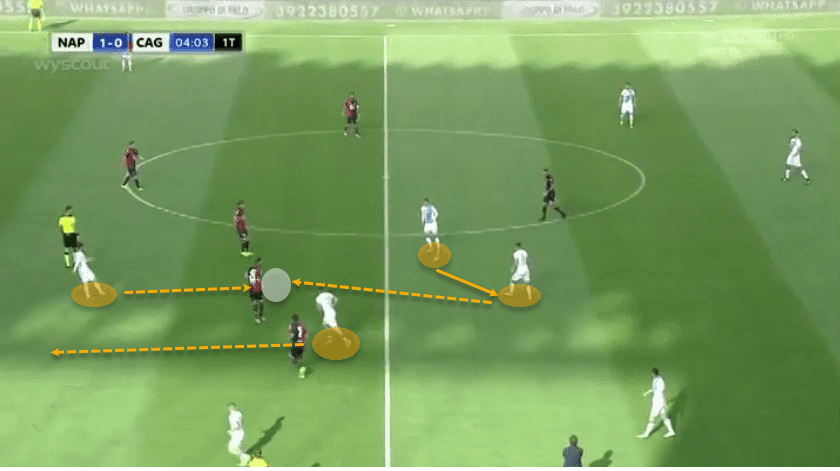
This passage of play against Cagliari perfectly portrayed how Napoli’s midfield and forward players’ movements opened up vertical passing options and space for Jorginho to pass into. Jorginho is exceptional at reading match situations and his intelligence here to pass into the player dropping into a deeper position is excellent. He plays a one-two pass combination with Piotr Zieliński to create time for Insigne to drop into position.
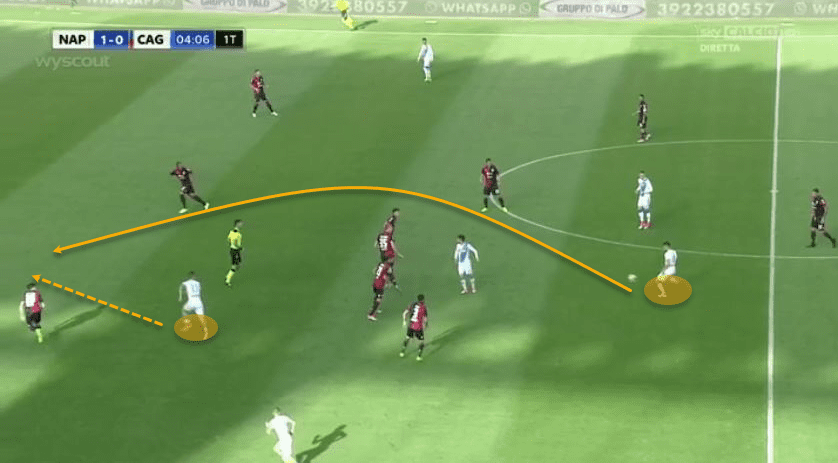
Insigne’s movement has created space between the lines and has allowed Hamšík to make an unmarked run into the final third. The space for Faouzi Ghoulam on the near side is a by-product of the Slovakian’s run forward attracting two players towards him.
The main take away from this is the intelligent movement of Napoli’s attackers who understood Sarri’s tactics and allowed Jorginho to thrive in his role. Even if opposition teams pressed Jorginho there would always be a passing option for him to recycle the ball. Having progressive, competent ball-playing centre-backs behind him also alleviated pressure off him in the build-up phase. At Napoli, he averaged 102.71 passes and 7.16 long passes per 90 indicating his importance and how frequently he was used as the team’s creative outlet going forward.
Now that we have understood how he was utilised at Napoli, we will explore the issues that made him an enigma at Chelsea in his first season.
Jorginho under Maurizio Sarri – Pressure in transitioning
A lot was expected from Jorginho from his first season at Chelsea. With Sarri appointed as manager, Jorginho soon followed and was crowned the jewel in the infamous ‘Sarriball’ system. Sarri looked to implement a similar system to the one he employed at Napoli. Jorginho’s role here was originally supposed to be similar to the deep-lying playmaking role he had at Napoli, however, it evolved into a half-back role.
The defensive midfielder eventually found himself playing between the centre-backs playing safe passes, recycling possession to the more advanced players. With Jorginho the only one well versed in ‘Sarriball’ it would take time for the first-team to understand the Italian’s new tactics especially since they were transitioning from a disciplined three-man system under Antonio Conte. Jorginho was affected by issues in all three phases of the pitch.
Starting with the defence, Sarri had David Luiz and Antonio Rüdiger as his preferred centre-back pairing. Luiz, in particular, found himself in favour because of his obvious ball-playing abilities alongside Rüdiger, however, neither player was as proficient as Koulibaly. Being able to play effectively between themselves once opposition strikers pressed them was a key component of ‘Sarriball’.
Both of Chelsea’s centre-backs were not very comfortable playing quick passes between each other especially with Premier League teams’ aggressive pressing styles putting extra undue pressure on Jorginho to distribute. This would force them to play it wide to the full-backs who in turn would recycle the ball to Jorginho. The ball would more often than not end up at Jorginho’s feet before it left the defensive third.
This could cause teams to man-mark Jorginho and force him to play much quicker than he is used to. Any time the centre-backs did distribute the ball forward they would resort to long-ranged passes upfront to no avail meaning Jorginho became even more important in the build-up phase. This was further backed by the lower number of passes (76.35) and long passes made per 90 (5.65). Jorginho had a lesser influence over Chelsea’s ball progression because teams were quick to press him giving him very little time to play more passes.
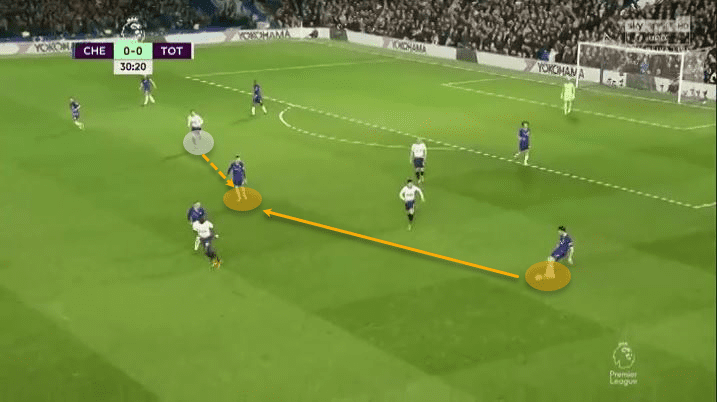
It’s clear to see against Tottenham Hotspur that every time Jorginho got on the ball, the closest attacking midfielder would pounce on the Italian midfielder. As Marcos Alonso’s is made to Jorginho, Erik Lamela has already started his press towards the midfielder. Unaware, Jorginho takes a touch and looks for a progressive pass but is quickly dispossessed and Spurs break on Chelsea high up the pitch. An early sign of the team not picking up every detail of ‘Sarriball’ is the centre-backs splitting wide and with Jorginho not dropping in between, Harry Kane and Son Heung-min have the opportunity to capitalise on the space.
Any opportunity Jorginho had to play to play freely was used by playing safe, possession recycling passes to nearby players to avoid the inevitable press and Sarri’s insistence on vertical build-ups. Jorginho had shown glimpses of his ability in his first season. One stand out example can be seen in the game against Manchester City when Pep Guardiola decided against man-marking the Brazilian. Chelsea were 2-0 victors on the day.
Lack of midfield support
One of Jorginho’s biggest issues came from problems in midfield. With N’Golo Kante playing as the right-sided midfielder, his role was to play as a ‘carrilero’, moving horizontally and vertically, creating space and offering a progressive passing option playing the Allan role. Mateo Kovačić or Ross Barkley would be given license to attack down the left side just as Hamšík did. At Napoli, Jorginho would usually be surrounded by Hamšík and Allan who almost always offered him at least one passing option. They would play off each other to create space in the final third.
At Chelsea, there were many times where the other two midfielders would push forward and not be close enough to Jorginho to offer him an easy passing option to bypass the press. Both looked to make more off-the-ball forward runs than drop deep to gradually build-up vertically. This would result in Jorginho being left isolated allowing the opposition press to come onto him.
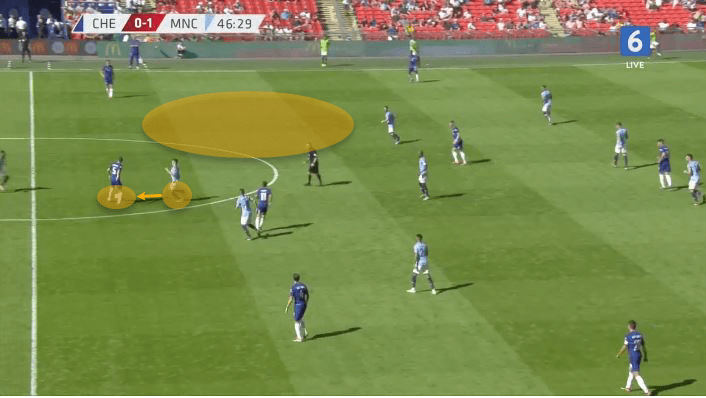
This was clearly seen in an early-season game against Manchester City where Jorginho was left isolated against the relentless pressing of City’s forwards. As Pedro passes to Jorginho, the midfielder is being closed down by Phil Foden. We can already see a clear issue here with no Chelsea players anywhere near Jorginho offering him a passing option or support in case City dispossesses him and counter-attack. Barkley is much too high and should be in the vacant space to Jorginho’s left to help progress play.

If we examine both of his pass maps together, notice how Jorginho played in a slightly deeper role for Chelsea and is much closer to the two centre-backs (#30 & #2) than he is to his two central midfield partners (#7 & #17). Jorginho’s stint at Napoli has him playing slightly further up the pitch closer to Allan and Hamšík. There is a staggering difference in the number of passes made into the final third from 21.5 to 13.75 per 90. His long passes reduced from 6.72 to 5.65 per 90 comparing his Napoli statistics to his first season at Chelsea. These changes can be attributed to his change in role to a half-back and English teams pressing much more.
Jorginho under Frank Lampard – Transition adjustments
After Sarri’s departure to Juventus, Lampard was soon appointed in the wake of the club’s transfer ban. With a reputation of blooding in youngsters and playing attractive football, he was expected to lead the clubs youth revolution. Jorginho’s place was under threat and there was a thought he might move on after Sarri left the club. Fast forward to the current setup and Jorginho is one of Lampard’s most important players.
Not only has he been a mainstay in the side but has transformed himself into the player that was much sought after by Guardiola. He has transformed himself from a half-back to a roaming playmaker whilst still remaining as the team’s number 6. As we discussed earlier, one of the easiest ways to nullify his threat was through a heavy pressing system on Jorginho. The following section will not only detail the changes he’s made to become more effective but how he has adapted his game.
Lampard’s system has been well documented but there are certain aspects that have benefited Jorginho but he has shown a stark improvement in his own game and that has propelled the players around him. Changes in central defence and better dynamic movement from Chelsea’s forwards have resulted in better cohesion between all three phases. The forwards and attacking midfielders drop in between the lines finding space to receive a pass.
One of Lampard’s biggest changes was the introduction of Fikayo Tomori into central defence. The English youngster’s progress under Lampard was excellent and were it not for a wantaway Luiz, Tomori would have been on loan. The youngster’s ability to play out from the back is impeccable and has relieved much of the pressure of transitioning off Jorginho. The difficulties faced last season when Luiz and Rüdiger were unable to play quick short passes and heavily relied on Jorginho was one of the main conundrums Lampard had to fix.
While Luiz is known for his exceptional passing skills and ball-carrying abilities, his lack of positional awareness was his biggest downfall. We would often see Luiz foray forward in possession to try and bypass Jorginho but would linger on the ball too long. This would result in him losing possession higher up the pitch leaving Jorginho to fill in at centre-back and be exposed. These forward movements are similar to what Tomori and Koulibaly do but their composure and positional awareness proves to be the difference.
Napoli and Koulibaly were agile and constantly moved to create space for the defenders to drive forward. Chelsea’s new midfield is similar to Napoli’s where they are also constantly moving into space bypassing teams aggressive press. With the help of Chelsea’s reinvigorated midfield, Tomori feels much safer passing and driving forward with a new fluidity in midfield. He often makes better decisions on whether to pass forward, to Jorginho or drive forward himself.
The centre-back has been taking a more pro-active approach either through direct passes to the more advanced midfielders or progress the ball into midfield. Tomori’s inclusion in the team has seen Chelsea progress possession into the opponents’ half breaking midfield lines. This allows Jorginho to avoid being constantly pressed and find space in midfield to receive the ball. From this position, Jorginho can scan his forward options and creates more time on the ball for himself. This is very reminiscent of his time at Napoli.
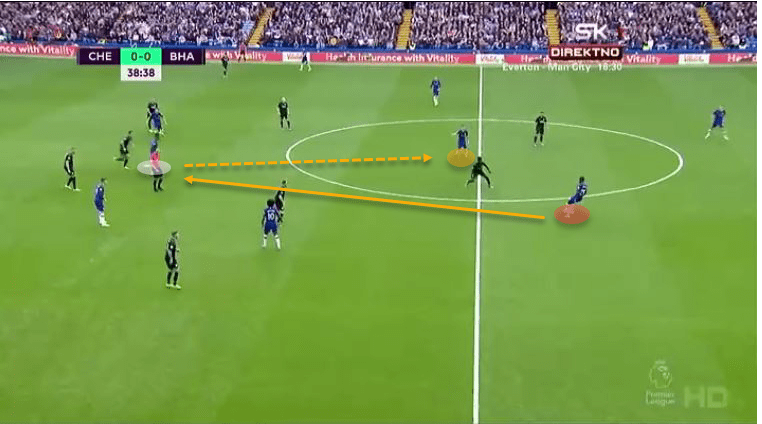
We can see an example of their cohesive build-up in the passage of play above. Tomori brings the ball forward and searches for a passing option. Tammy Abraham can be seen dropping deep into midfield to break Brighton’s structured shape and create space for his teammates to move in. The space vacated by Tomori’s marker is smartly utilised by Jorginho and is now in space to operate.
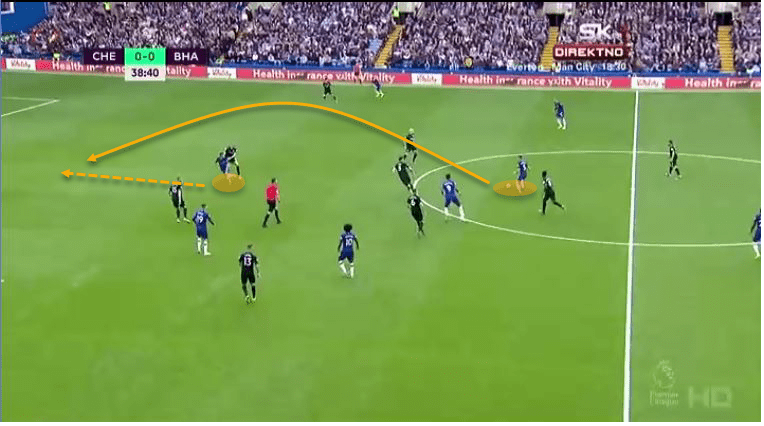
The two wingers are stationed in a much narrower position in between the lines of midfield and defence to move in an inward or outward direction. Abraham’s movement pulled his marker with him and opened a gap. Jorginho receives the layoff pass from Abraham and he immediately releases a long pass over the top for Pedro to run onto. This passage of play is very reminiscent of the type of football that was regularly witnessed at Napoli. While his numbers may similar to last season the freedom and space he has from the inclusion of Tomori and forward movement has made his passing statistics much more effective.
Midfield improvement – Partnership with Mateo Kovačić
Lampard’s introduction has not only seen Chelsea become one of the surprise packages of the season but has also overseen the resurgence of a number of players. With Kante experiencing a turbulent season ravaged by injuries, Kovačić has been a standout performer for Chelsea and his partnership with Jorginho has played a significant part in the Italian’s improvement. Kovačić has allowed Jorginho to play with more freedom and has in part the reason behind his move into a roaming playmaker.
The two players have formed a solid partnership and Jorginho has been freed from being anchored at the base of midfield at all times. The fluidity in the midfield double-pivot has made Chelsea into a high-octane, top goal-scoring team. Kovačić’s strengths lie in his ability to drive from deep midfield positions, interchanging quick passes and being able to cover ground across midfield.

This pass map clearly shows the stark difference in positions between now and last season. Kovačić (#17) sits deeper and closer to Jorginho this season whereas last season both him and Kante (#7) were stationed further forward. This has relieved pressure off Jorginho and given space and time to play his natural game. The Croatian has played a lot closer to Jorginho offering him protection and a passing option at all times and giving him that license to affect the game in the forward areas.
Jorginho is a highly intelligent player and his mental attitude makes him one of the best defensive midfield playmakers. He is seen orchestrating the game with his confident demeanour. One of the ways he has been able to marshal Chelsea’s midfield is by instructing players to move into different positions to help progress the ball forward. This has allowed him to balance space creation and defensive protection. This season we have seen Jorginho interchange positions with Kovačić allowing him to take these advanced positions whilst having at least one player protecting the back four.
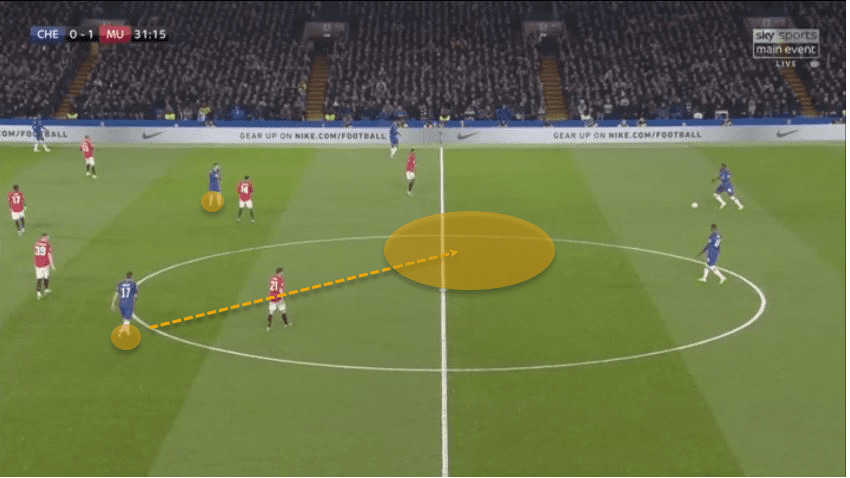
A perfect example can be seen here against Manchester United in the League Cup. Both Jorginho and Kovačić are slightly higher up the pitch but the Italian is quick to recognise the danger of both players staying up. He can be seen pointing towards the vacant space instructing Kovačić to fill the gap. This will protect Chelsea from a potential counter-attack if United win possession in midfield.
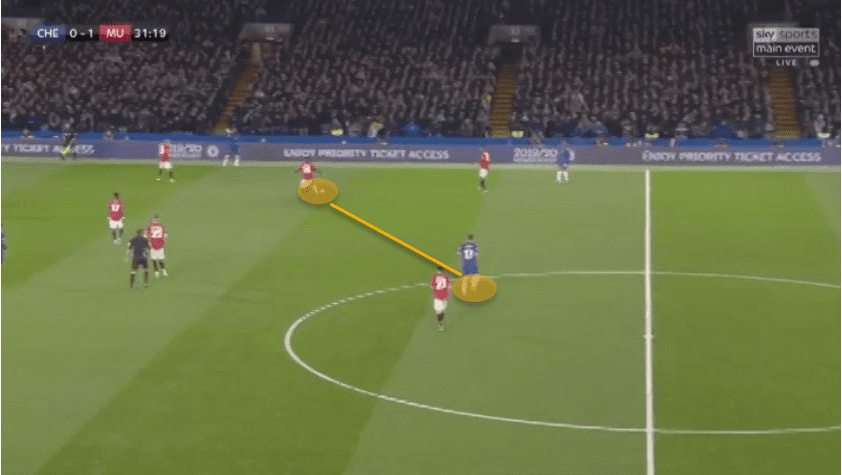
As the ball makes its way to Jorginho, we can see Kovačić filling in the gap with the Italian midfielder in a higher position. Even though he is being closed down by Jesse Lingard, the risk of exposing United’s pace to Chelsea’s defence diminishes with Kovačić protecting him.
Not only have they intelligently exchanged positions to balance their positions on the pitch but also moving players out of position to open space for each other to play through. We’ve seen Kevin De Bruyne and David Silva conjure up a similar exchange in City’s midfield and this style suits Chelsea’s new style of play. Both Kovačić and Jorginho are excellent in possession and against Ajax showed how their combined intelligent game sense and quick feet affected the game.
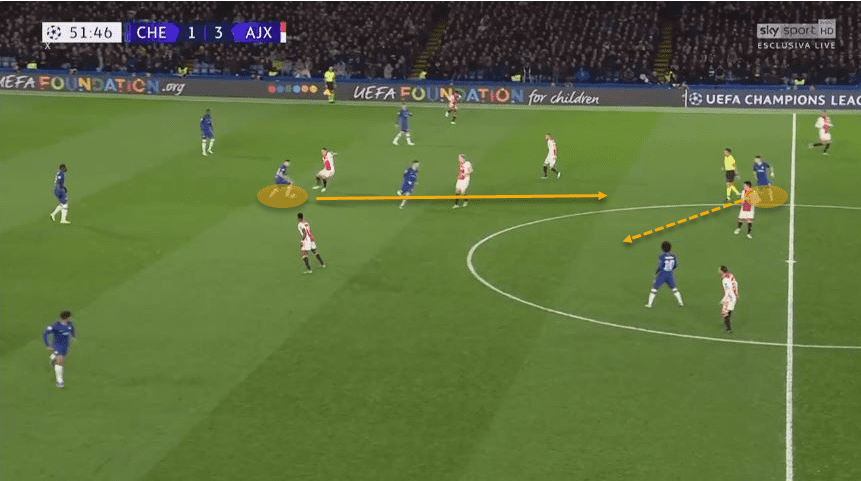
First, it’s important to note the distance between the two midfielders. Kovačić has picked up possession from a deeper position while Jorginho is higher up the pitch. There are three Ajax players between Kovačić and Jorginho and the Croatian needs to find a way through.
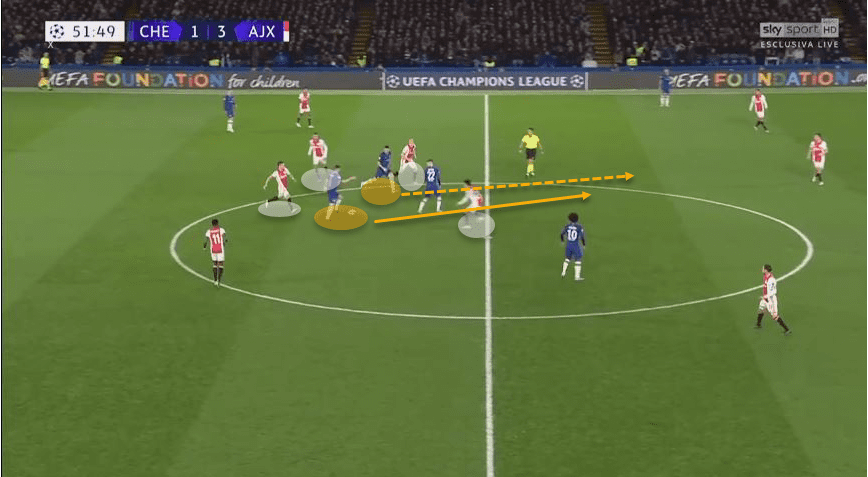
While Kovačić’s dribble requires all three players to try and deal with him, Jorginho drops slightly compressing the space and reroutes the Ajax players’ attention towards him as he receives the pass. This allows Kovačić to continue his run into the space vacated by Jorginho and bypass all of Ajax’s midfield to progress possession forward.
Conclusion
The Italian midfielder has been ever-present for Chelsea this season and his transformation has been one of the best tactical success stories of 2019. The way in which he has been able to go from a seemingly one-dimensional player that was partially limited by a system has now shown how effective he can be in England. Jorginho has not only displayed the qualities that he showed at Napoli but he has adapted to the league by tailoring his game. At Napoli, he was a lot more static pinging passes from a certain area of midfield but has now become a roaming playmaker that has found a way to better avoid the heavy pressing style that most teams employ.
The season is reaching the half-way point and Chelsea are hovering near the top of the table. Much of their success going forward has come courtesy of Jorginho. Lampard and co. will need his experience, leadership, and creativity to navigate through the rest of the season if they want to stand any chance of securing a top-four position. With the stark changes he has made in the past year, we could be witnessing the start of a new era at Chelsea with Jorginho leading the charge with a band of exceptionally talented youngsters.

If you love tactical analysis, then you’ll love the digital magazines from totalfootballanalysis.com – a guaranteed 100+ pages of pure tactical analysis covering topics from the Premier League, Serie A, La Liga, Bundesliga and many, many more. Buy your copy of the November issue for just ₤4.99 here






Comments